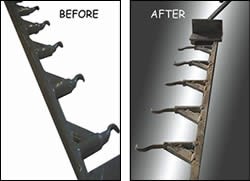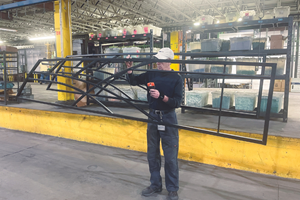Powder Coating: Keeping Racks Clean
Every electrostatic powder coating shop has to find a way to remove powder buildup on racks and fixtures to maintain electrical conductivity. Finishers typically have two options: outsource the cleaning or install in-house stripping...
Every time a rack passes through a powder coating system the rack is powder coated along with the items being finished. The coating applied repeatedly to the rack quickly becomes a problem, since it insulates the rack more and more with each pass, progressively decreasing part-to-rack conductivity.
Proper conductivity and electrical grounding are imperative to assure consistent, quality powder coating. Inadequate grounding causes poor adhesion and non-uniform coating thickness as well as safety problems. Just one megohm of resistance between part and hanger may result in arcing, spark generation and fire danger.
Poor conductivity degrades transfer efficiency as well. Ideally, with good conductivity, says the Powder Coating Institute, transfer efficiency guidelines are as follows:
- 60% inside solid box
- 50% outside large solid pieces
- 40% outside small solid pieces
- 20% wire
After a day of use, hangers may collect 1-2 mils of coating material, and after only one pass transfer efficiency can drop by 50-60%. Thus conductivity has been degraded and transfer efficiency is even lower than indicated by these guidelines. More and more powder must be recirculated.
Most finishers deal with this problem in one way or another, some by crudely grinding down contact points to restore conductivity. But eventually, all finishers have to strip away the coating buildup from the racks and fixtures. Usually, those who want to maintain good efficiency and minimize waste will strip racks at the end of each day.
Some finishers prefer not to deal with rack stripping. They out-source the cleaning job. That works. Stripping becomes a specialist’s problem and the finisher does not have to spend time stripping. There is no stripping equipment to buy and maintain, nor is labor needed to operate it. But there are some disadvantages, too.
- The cost of having racks and hangers stripped by the outside source.
- The cost of labor to package, ship and unpack racks.
- The finishing shop must buy or fabricate additional racks, since racks sent out for stripping are not available to the production line. Thus, a powder coating shop will need at least twice as many racks as are in use on the line at any given time.
- Racks may be damaged in shipping to and from the strip shop, and in the process of coating removal. Some stripping shops use very high temperatures to burn off coating buildup quickly. Too-high tem- peratures can soften the rack, which shortens its useful life.
- Installing equipment to strip racks and hangers in-house is a capital expenditure. Finishers have to measure this cost against that of out-sourcing. Advantages of in-house stripping include the following:
- Process uniformity. If the finisher cleans racks and hangers daily there is much less variation in conductivity which yields better coating uniformity.
- Reject parts and even filters can be cleaned if one installs the proper system and accessories.
- In-house cleaning provides control over the stripping pro- cess, lessening danger of rack damage.
- Fewer racks, hangers and fixtures are required, since there is no need to have so many extra racks and fixtures for use while others are out for stripping.
When it comes to in-house solutions for stripping racks and fixtures, a number of solutions are available. Among them, chemical stripping, mechanical stripping and pyrolytic stripping. The latter may include the use of heat-cleaning ovens, open flames, hot fluidized beds, molten salt baths and lasers. Burn-off ovens—also called heat cleaning ovens—are a popular tool for stripping powder coated racks and parts.
Unlike bake-off ovens—which typically operate at 250-500°F—burn-off ovens usually run at 700-900°F or greater, causing the coating to burn without flame, which is called pyrolysis. An integral water system suppresses the generation of any open flame. Once the coatings have been burned, any resulting ash can be removed with a pressure washer.
While some burn-off ovens are ideal for use on racks and fixtures, there are some designs that offer better control over the oven temperatures so that they can strip even sensitive parts such as aluminum and thin sheet steel, even some paint filters. Tight control results in very uniform temperatures and reduction of hot and cold spots.
Although burn-off ovens are an excellent tool for removing organic coatings from racks and hangers, finishers should lend thoughtful consideration to factors such as substrate, rack size, coating type, return on investment, operating costs, environmental impact and employee safety before committing to a particular stripping technology or deciding whether to perform the stripping process in-house or outsourcing it.
Related Content
TTX’s Automated Conveyor Carrier System Offers Wireless, Flexible Operation
ACC system designed for reliable, consistent point-to-point movement of everything from small to heavy parts.
Read More12 Ways to Improve Your Powder Coating Quality
Often overlooked powder coating procedures that can help you elevate your quality, streamline your operations and improve your profitability.
Read MoreProducts Finishing Reveals 2023 Qualifying Top Shops
Each year PF conducts its Top Shops Benchmarking Survey, offering shops a tool to better understand their overall performance in the industry. The program also recognizes shops that meet a set of criteria to qualify as Top Shops.
Read MorePowder Coating Overcomes Post Forming
Six Sigma methodology, open communication, and collaboration produce results for leading boat manufacturer.
Read MoreRead Next
Episode 45: An Interview with Chandler Mancuso, MacDermid Envio Solutions
Chandler Mancuso, technical director with MacDermid Envio discusses updating your wastewater treatment system and implementing materials recycling solutions to increase efficiencies, control costs and reduce environmental impact.
Read MoreA ‘Clean’ Agenda Offers Unique Presentations in Chicago
The 2024 Parts Cleaning Conference, co-located with the International Manufacturing Technology Show, includes presentations by several speakers who are new to the conference and topics that have not been covered in past editions of this event.
Read MoreDelivering Increased Benefits to Greenhouse Films
Baystar's Borstar technology is helping customers deliver better, more reliable production methods to greenhouse agriculture.
Read More























